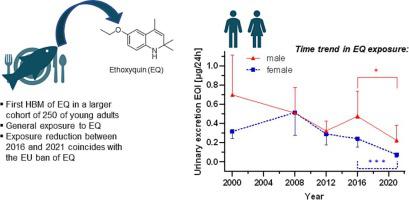Environment International ( IF 10.3 ) Pub Date : 2023-02-04 , DOI: 10.1016/j.envint.2023.107781 Nikola Pluym 1 , Therese Burkhardt 1 , Nadine Rögner 1 , Gerhard Scherer 1 , Till Weber 2 , Max Scherer 1 , Marike Kolossa-Gehring 2

|
Human Biomonitoring (HBM) of emerging chemicals gained increasing attention within the EU in recent years. After evaluating the metabolism, we established a new HBM method for ethoxyquin (EQ), a feed additive, which was banned in 2017 due to concerns regarding the possible exposure of the general population to it and its highly toxic precursor p-phenetidine. The method was applied to 250 urine samples from the Environmental Specimen Bank collected between 2000 and 2021. The major metabolite EQI was quantified in the majority of the study samples illustrating the ubiquitous exposure of the non-occupationally exposed population. A rather constant exposure was observed until 2016 with a significant decline from 2016 to 2021. This drop falls within the EU wide ban of the chemical as a feed additive from June 2017 which led to a gradual removal until its complete suspension in June 2020. The daily intake (DI) was evaluated with respect to the reported derived no-effect level (DNEL) to estimate the potential health risks from EQ exposure. The median DI of 0.0181 µg/kg bw/d corresponds to only 0.01 % of the DNEL. Even the observed maxima up to 13.1 µg/kg bw/d only accounted for 10 % of the DNEL. Nevertheless, the values suggest a general exposure with the risk of higher burden in a low fraction of the population. In regard to the EQ associated intake of the carcinogen and suspected mutagen p-phenetidine, this level of exposure cannot be evaluated as safe. The recent decrease and the broad exposure substantiate the need for future HBM campaigns in population representative studies to further investigate the observed reductions, potentially find highly exposed subgroups and clarify the impact of the ban as feed additive on EQ exposure.
中文翻译:

监测 2000 年至 2021 年间德国环境标本库尿样中乙氧喹的暴露情况
近年来,新兴化学品的人体生物监测 (HBM) 在欧盟范围内受到越来越多的关注。在评估代谢后,我们为乙氧喹 (EQ) 建立了一种新的 HBM 方法,乙氧喹是一种饲料添加剂,由于担心普通人群可能接触它及其剧毒前体 p-phenetidine,该添加剂于 2017 年被禁用。该方法应用于 2000 年至 2021 年间从环境标本库收集的 250 个尿样。在大多数研究样本中对主要代谢物 EQI 进行了量化,说明非职业暴露人群的普遍暴露。直到 2016 年,观察到的暴露量相当稳定,从 2016 年到 2021 年显着下降。这一下降属于欧盟自 2017 年 6 月起广泛禁止将该化学品作为饲料添加剂的范围,该禁令导致该化学品逐渐被禁止,直到 2020 年 6 月完全暂停。每日摄入量 (DI) 是根据报告的衍生无影响水平进行评估的(DNEL) 来估计 EQ 暴露的潜在健康风险。0.0181 µg/kg bw/d 的中值 DI 仅对应 DNEL 的 0.01%。即使观察到的最大值高达 13.1 µg/kg bw/d 也仅占 DNEL 的 10%。然而,这些值表明在一小部分人群中普遍暴露于较高负担的风险中。关于与 EQ 相关的致癌物质和疑似诱变剂 p-phenetidine 的摄入量,该暴露水平不能被评估为安全的。

































 京公网安备 11010802027423号
京公网安备 11010802027423号